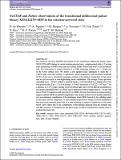Por favor, use este identificador para citar o enlazar a este item:
http://hdl.handle.net/10261/237074COMPARTIR / EXPORTAR:
 SHARE SHARE
 CORE
BASE CORE
BASE
|
|
| Visualizar otros formatos: MARC | Dublin Core | RDF | ORE | MODS | METS | DIDL | DATACITE | |

| Título: | NuSTAR and Parkes observations of the transitional millisecond pulsar binary XSS J12270-4859 in the rotation-powered state |
Autor: | De Martino, D.; Papitto, Alessandro CSIC ORCID; Burgay, M.; Possenti, A.; Coti Zelati, Francesco CSIC ORCID ; Rea, Nanda CSIC ORCID; Torres, Diego F. CSIC ORCID; Belloni, T. | Palabras clave: | Binaries: close Gamma-rays: stars Pulsars: general Stars: Individual:XSS J12270-4859 (aka 1FGL J1227.9-4852, 2FGL J1227.7-4853, 3FGL J1227.9-4854, PSR J1227-4853) X-ray binaries |
Fecha de publicación: | 21-ene-2020 | Editor: | Royal Astronomical Society | Citación: | Monthly Notices of the Royal Astronomical Society 492(4): 5607-5619 (2020) | Resumen: | We report on the first NuSTAR observation of the transitional millisecond pulsar binary XSS J12270-4859 during its current rotation-powered state, complemented with a 2.5 yr-long radio monitoring at Parkes telescope and archival XMM-Newton and Swift X-ray and optical data. The radio pulsar is mainly detected at 1.4 GHz displaying eclipses over ∼ 40 per cent of the 6.91 h orbital cycle. We derive a new updated radio ephemeris to study the 3- 79 keV light curve that displays a significant orbital modulation with fractional amplitude of 28 ± 3 per cent, a structured maximum centred at the inferior conjunction of the pulsar and no cycle-to-cycle or low-high-flaring mode variabilities. The average X-ray spectrum, extending up to ∼70 keV without a spectral break, is well described by a simple power law with photon index γ = 1.17 ± 0.08 giving a 3-79 keV luminosity of 7.6+3.8 -0.8 × 1032 erg s-1 for a distance of 1.37+0.69 -0.15 kpc. Energy resolved orbital light curves reveal that the modulation is not energy dependent from 3 to 25 keV and is undetected with an upper limit of ∼10 per cent above 25 keV. Comparison with previous X-ray XMM-Newton observations in common energy ranges confirms that themodulation amplitudes vary on time-scales of a fewmonths, indicative of a non-stationary contribution of the intrabinary shock (IBS) formed by the colliding winds of the pulsar and the companion. A more detailed inspection of energy resolved modulations than previously reported gives hints of a mild softening at superior conjunction of the pulsar below 3 keV, likely due to the contribution of the thermal emission from the neutron star. The IBS emission, if extending into the MeV range, would be energetically capable alone to irradiate the donor star. | Versión del editor: | http://doi.org/10.1093/mnras/staa164 | URI: | http://hdl.handle.net/10261/237074 | DOI: | 10.1093/mnras/staa164 | Identificadores: | doi: 10.1093/mnras/staa164 issn: 1365-2966 |
| Aparece en las colecciones: | (ICE) Artículos |
Ficheros en este ítem:
| Fichero | Descripción | Tamaño | Formato | |
|---|---|---|---|---|
| NuSTAR_and_Parkes_observations_of_pulsar_binary_XSS_J12279-4859.pdf | 937,57 kB | Adobe PDF |  Visualizar/Abrir |
CORE Recommender
SCOPUSTM
Citations
9
checked on 17-abr-2024
WEB OF SCIENCETM
Citations
8
checked on 25-feb-2024
Page view(s)
59
checked on 23-abr-2024
Download(s)
136
checked on 23-abr-2024
Google ScholarTM
Check
Altmetric
Altmetric
NOTA: Los ítems de Digital.CSIC están protegidos por copyright, con todos los derechos reservados, a menos que se indique lo contrario.
